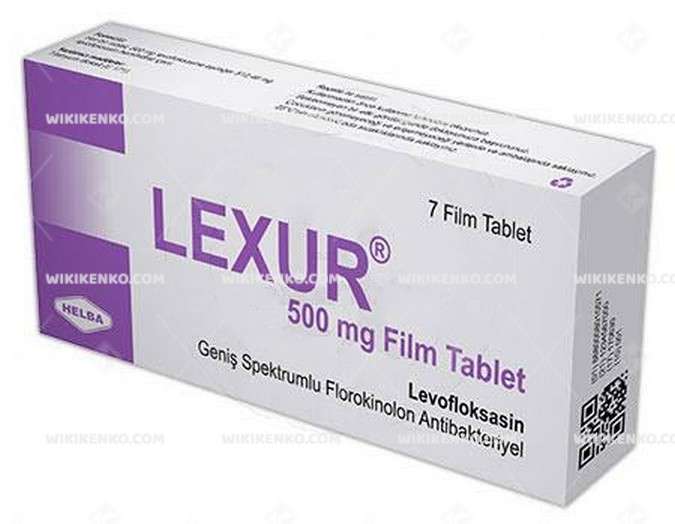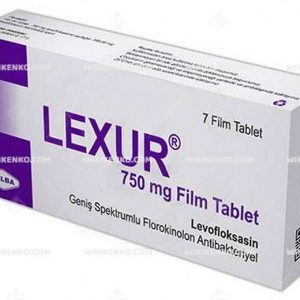Lexur Film Tablet 500 Mg
In the realm of antibiotics, Lexur Film Tablet 500 Mg stands as a stalwart defender against a multitude of bacterial infections. This comprehensive guide offers an intricate look into Lexur, elucidating its composition, indications, dosage, mechanism of action, side effects, storage recommendations, and critical considerations for pregnant women.
| Dosage form | |
|---|---|
| Pack size | |
| Potency | 500 Mg |
| Manufacturer | Helba |
| Origin | Turkey |
| Generic Name (Ingredient) | 512.46 Mg Levofloxacin Hemihydrate (Equivalent To 500 Mg Levofloxacin) |
Assuming your emergency circumstances for this product, visit Urgent Quotation page. Besides, for any pharmaceutical questions, please ask us in the comments section.
Description
Indications
Lexur is a medical warrior meticulously crafted for the battle against bacterial infections susceptible to levofloxacin’s prowess. The versatile applications of Lexur encompass the treatment of various conditions, including:
- Community-Acquired Pneumonia
- Complicated Urinary Tract and Kidney Infections: This includes pyelonephritis.
- Prostatitis
- Skin and Soft Tissue Infections: Such as abscesses, cellulitis, furuncles, impetigo, pyoderma, and wound infections.
- Exposure to Airborne Anthrax Bacteria
In cases where alternative treatments are scarce, Lexur can also be deployed, provided it aligns with the guidance of an infectious diseases specialist, for:
- Acute Bacterial Sinusitis
- Acute Exacerbation of Chronic Bronchitis
The wide spectrum of its applications underscores Lexur’s importance in the medical arsenal.
Ingredients
| Active Ingredient | Levofloxacin |
|---|---|
| Tablet Strength | 500 mg |
| Equivalent to | 512.46 mg of levofloxacin hemihydrate |
| Excipients | Hydroxypropyl cellulose, crospovidone, microcrystalline cellulose, colloidal silicon dioxide, magnesium stearate, hydroxypropyl methylcellulose, stearic acid, titanium dioxide |
Dosage and Administration
Lexur is administered orally, with the specific dosage and treatment duration tailored to the type and severity of the infection at hand. For example, in cases of acute bacterial sinusitis, a daily dose of 500 mg for 10-14 days or a daily dose of 750 mg for 5 days may be recommended. The precision in dosing is vital to ensure the effective eradication of the offending bacteria.
Side Effects
Like all medications, Lexur can come with side effects. In the case of fluoroquinolones like Lexur, these side effects can occasionally take a serious turn. Some noteworthy adverse reactions associated with Lexur encompass:
- Tendon Inflammation and Rupture
- Peripheral Neuropathy: Involving disorders in the peripheral nerves.
- Effects on the Central Nervous System: Such as confusion, dizziness, loss of consciousness, and seizures.
- Worsening of Myasthenia Gravis: A disease characterized by muscle weakness.
While these side effects are indeed severe, it’s essential to remember that not everyone will experience them. Awareness and prompt reporting of any unusual symptoms are critical.
Safekeeping Lexur
While the specific storage conditions for Lexur are not mentioned in the provided information, it is generally advisable to store medications in a cool, dry place, safeguarded from direct sunlight. Ensuring the integrity of the medication through proper storage is essential for its effectiveness.
Levofloxacin Mechanism
Levofloxacin, the active ingredient in Lexur, is a formidable antibiotic that exerts its power by inhibiting two critical bacterial enzymes: topoisomerase IV and DNA gyrase. These enzymes are pivotal for bacteria’s ability to replicate and mend their DNA.
By converting these enzymes into toxic forms, levofloxacin disrupts the production and repair of DNA, halting various DNA processes within the bacterial cells. This relentless action ultimately leads to the bacteria’s demise, thereby eradicating the infection.
It’s essential to underscore that levofloxacin is a broad-spectrum antibiotic, signifying its effectiveness against a wide range of bacterial adversaries. However, its usage should be judiciously overseen by a healthcare professional to ensure appropriate administration and prevent the emergence of antibiotic resistance.
Levofloxacin’s Response Time
The timeline for levofloxacin to exhibit its efficacy can fluctuate, contingent on factors such as the infection type, its severity, and individual patient characteristics. Nevertheless, patients might observe an amelioration of their symptoms within a few days of commencing the medication. It is paramount to complete the entire prescribed course of treatment, even if symptoms ameliorate before the regimen concludes. This approach ensures the thorough elimination of the infection and mitigates the risk of bacterial resistance to the antibiotic.
The frequency and dosage of Lexur, housing levofloxacin, hinge upon the type and gravity of the infection necessitating treatment. Typically administered orally, the precise dosage should be determined by a healthcare provider. Patients should unwaveringly adhere to the instructions imparted by their healthcare professionals and must refrain from adjusting their dosage independently. If questions or concerns arise regarding medication, consulting a healthcare provider is the most prudent course of action.
Pregnancy
Levofloxacin, the chief component of Lexur, is generally considered safe for use during pregnancy. Animal studies have not unveiled evidence of adverse developmental outcomes, fetal harm, or impaired fertility. However, a few caveats deserve attention. Levofloxacin crosses the placental barrier into cord blood and amniotic fluid.
Yet, despite the reassuring data from epidemiologic studies, case series, and case reports, which have not indicated an association between cephalosporin use (including this drug) during pregnancy and major birth defects, miscarriages, or adverse maternal/fetal outcomes, a definitive absence of risk remains unestablished. Consequently, it is imperative to consult a healthcare professional before embracing any medication during pregnancy. Their expertise will illuminate the potential risks and rewards tailored to one’s specific circumstances.
Conclusion
In summation, Lexur Film Tablet 500 Mg, fortified by the formidable levofloxacin, emerges as an invaluable ally against a plethora of bacterial foes. This guide has unfurled the intricacies of Lexur, from its composition and multifaceted indications to its precise dosage and mechanism of action. It has also shed light on potential side effects, safe storage practices, and crucial considerations for expectant mothers.
Always remember, when it comes to medication, informed decisions are the bedrock of safe and effective treatment. Therefore, seek the counsel of a healthcare professional to navigate the path towards health and healing.
Use the form below to report an error
Please answer the questions as thoroughly and accurately as possible. Your answers will help us better understand what kind of mistakes happen, why and where they happen, and in the end the purpose is to build a better archive to guide researchers and professionals around the world.
The information on this page is not intended to be a substitute for professional medical advice, diagnosis, or treatment. always seek the advice for your physician or another qualified health provider with any questions you may have regarding a medical condition. Always remember to
- Ask your own doctor for medical advice.
- Names, brands, and dosage may differ between countries.
- When not feeling well, or experiencing side effects always contact your own doctor.
Cyberchondria
The truth is that when we’re sick, or worried about getting sick, the internet won’t help.
According to Wikipedia, cyberchondria is a mental disorder consisting in the desire to independently make a diagnosis based on the symptoms of diseases described on Internet sites.
Why you can't look for symptoms on the Internet
If diagnoses could be made simply from a textbook or an article on a website, we would all be doctors and treat ourselves. Nothing can replace the experience and knowledge of specially trained people. As in any field, in medicine there are unscrupulous specialists, differences of opinion, inaccurate diagnoses and incorrect test results.




Reviews
There are no reviews yet.